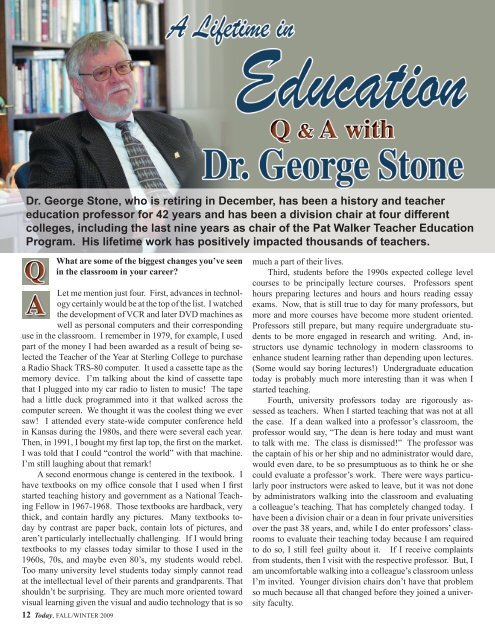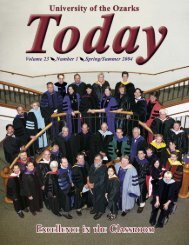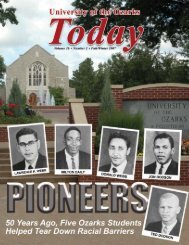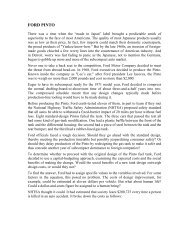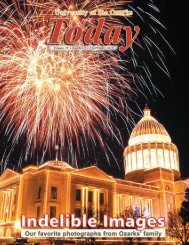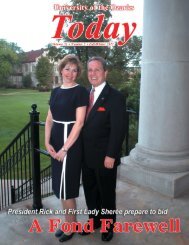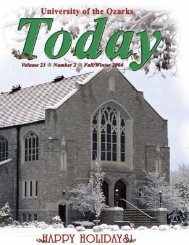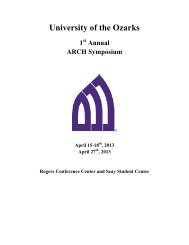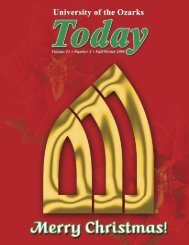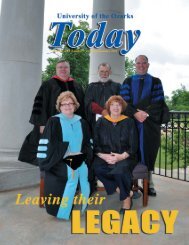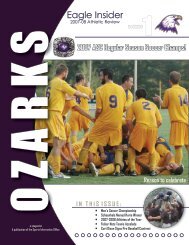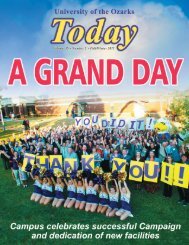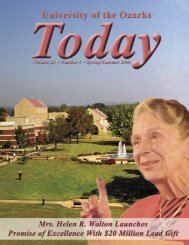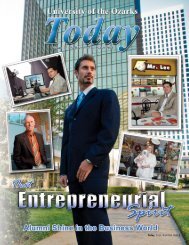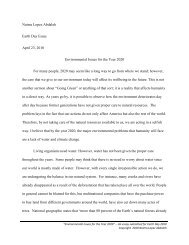Download - University of the Ozarks
Download - University of the Ozarks
Download - University of the Ozarks
You also want an ePaper? Increase the reach of your titles
YUMPU automatically turns print PDFs into web optimized ePapers that Google loves.
Dr. George Stone, who is retiring in December, has been a history and teacher<br />
education pr<strong>of</strong>essor for 42 years and has been a division chair at four different<br />
colleges, including <strong>the</strong> last nine years as chair <strong>of</strong> <strong>the</strong> Pat Walker Teacher Education<br />
Program. His lifetime work has positively impacted thousands <strong>of</strong> teachers.<br />
What are some <strong>of</strong> <strong>the</strong> biggest changes you’ve seen<br />
in <strong>the</strong> classroom in your career<br />
Let me mention just four. First, advances in technology<br />
certainly would be at <strong>the</strong> top <strong>of</strong> <strong>the</strong> list. I watched<br />
<strong>the</strong> development <strong>of</strong> VCR and later DVD machines as<br />
well as personal computers and <strong>the</strong>ir corresponding<br />
use in <strong>the</strong> classroom. I remember in 1979, for example, I used<br />
part <strong>of</strong> <strong>the</strong> money I had been awarded as a result <strong>of</strong> being selected<br />
<strong>the</strong> Teacher <strong>of</strong> <strong>the</strong> Year at Sterling College to purchase<br />
a Radio Shack TRS-80 computer. It used a cassette tape as <strong>the</strong><br />
memory device. I’m talking about <strong>the</strong> kind <strong>of</strong> cassette tape<br />
that I plugged into my car radio to listen to music! The tape<br />
had a little duck programmed into it that walked across <strong>the</strong><br />
computer screen. We thought it was <strong>the</strong> coolest thing we ever<br />
saw! I attended every state-wide computer conference held<br />
in Kansas during <strong>the</strong> 1980s, and <strong>the</strong>re were several each year.<br />
Then, in 1991, I bought my first lap top, <strong>the</strong> first on <strong>the</strong> market.<br />
I was told that I could “control <strong>the</strong> world” with that machine.<br />
I’m still laughing about that remark!<br />
A second enormous change is centered in <strong>the</strong> textbook. I<br />
have textbooks on my <strong>of</strong>fice console that I used when I first<br />
started teaching history and government as a National Teaching<br />
Fellow in 1967-1968. Those textbooks are hardback, very<br />
thick, and contain hardly any pictures. Many textbooks today<br />
by contrast are paper back, contain lots <strong>of</strong> pictures, and<br />
aren’t particularly intellectually challenging. If I would bring<br />
textbooks to my classes today similar to those I used in <strong>the</strong><br />
1960s, 70s, and maybe even 80’s, my students would rebel.<br />
Too many university level students today simply cannot read<br />
at <strong>the</strong> intellectual level <strong>of</strong> <strong>the</strong>ir parents and grandparents. That<br />
shouldn’t be surprising. They are much more oriented toward<br />
visual learning given <strong>the</strong> visual and audio technology that is so<br />
12 Today, FALL/WINTER 2009<br />
much a part <strong>of</strong> <strong>the</strong>ir lives.<br />
Third, students before <strong>the</strong> 1990s expected college level<br />
courses to be principally lecture courses. Pr<strong>of</strong>essors spent<br />
hours preparing lectures and hours and hours reading essay<br />
exams. Now, that is still true to day for many pr<strong>of</strong>essors, but<br />
more and more courses have become more student oriented.<br />
Pr<strong>of</strong>essors still prepare, but many require undergraduate students<br />
to be more engaged in research and writing. And, instructors<br />
use dynamic technology in modern classrooms to<br />
enhance student learning ra<strong>the</strong>r than depending upon lectures.<br />
(Some would say boring lectures!) Undergraduate education<br />
today is probably much more interesting than it was when I<br />
started teaching.<br />
Fourth, university pr<strong>of</strong>essors today are rigorously assessed<br />
as teachers. When I started teaching that was not at all<br />
<strong>the</strong> case. If a dean walked into a pr<strong>of</strong>essor’s classroom, <strong>the</strong><br />
pr<strong>of</strong>essor would say, “The dean is here today and must want<br />
to talk with me. The class is dismissed!” The pr<strong>of</strong>essor was<br />
<strong>the</strong> captain <strong>of</strong> his or her ship and no administrator would dare,<br />
would even dare, to be so presumptuous as to think he or she<br />
could evaluate a pr<strong>of</strong>essor’s work. There were ways particularly<br />
poor instructors were asked to leave, but it was not done<br />
by administrators walking into <strong>the</strong> classroom and evaluating<br />
a colleague’s teaching. That has completely changed today. I<br />
have been a division chair or a dean in four private universities<br />
over <strong>the</strong> past 38 years, and, while I do enter pr<strong>of</strong>essors’ classrooms<br />
to evaluate <strong>the</strong>ir teaching today because I am required<br />
to do so, I still feel guilty about it. If I receive complaints<br />
from students, <strong>the</strong>n I visit with <strong>the</strong> respective pr<strong>of</strong>essor. But, I<br />
am uncomfortable walking into a colleague’s classroom unless<br />
I’m invited. Younger division chairs don’t have that problem<br />
so much because all that changed before <strong>the</strong>y joined a university<br />
faculty.


